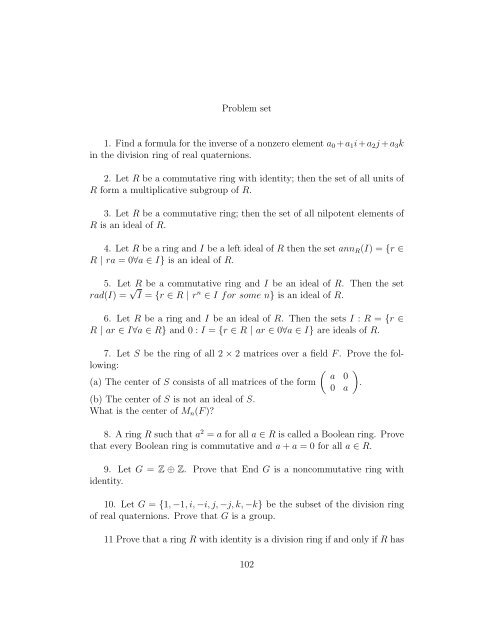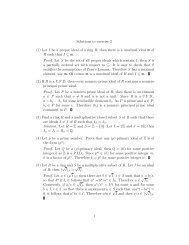Topics in algebra Chapter IV: Commutative rings and modules I - 1
Topics in algebra Chapter IV: Commutative rings and modules I - 1
Topics in algebra Chapter IV: Commutative rings and modules I - 1
Create successful ePaper yourself
Turn your PDF publications into a flip-book with our unique Google optimized e-Paper software.
Problem set<br />
1. F<strong>in</strong>d a formula for the <strong>in</strong>verse of a nonzero element a0 +a1i+a2j +a3k<br />
<strong>in</strong> the division r<strong>in</strong>g of real quaternions.<br />
2. Let R be a commutative r<strong>in</strong>g with identity; then the set of all units of<br />
R form a multiplicative subgroup of R.<br />
3. Let R be a commutative r<strong>in</strong>g; then the set of all nilpotent elements of<br />
R is an ideal of R.<br />
4. Let R be a r<strong>in</strong>g <strong>and</strong> I be a left ideal of R then the set annR(I) = {r ∈<br />
R | ra = 0∀a ∈ I} is an ideal of R.<br />
5. Let R be a commutative r<strong>in</strong>g <strong>and</strong> I be an ideal of R. Then the set<br />
rad(I) = √ I = {r ∈ R | r n ∈ I for some n} is an ideal of R.<br />
6. Let R be a r<strong>in</strong>g <strong>and</strong> I be an ideal of R. Then the sets I : R = {r ∈<br />
R | ar ∈ I∀a ∈ R} <strong>and</strong> 0 : I = {r ∈ R | ar ∈ 0∀a ∈ I} are ideals of R.<br />
7. Let S be the r<strong>in</strong>g of all 2 × 2 matrices over a field F . Prove the follow<strong>in</strong>g:<br />
<br />
a 0<br />
(a) The center of S consists of all matrices of the form .<br />
0 a<br />
(b) The center of S is not an ideal of S.<br />
What is the center of Mn(F )?<br />
8. A r<strong>in</strong>g R such that a 2 = a for all a ∈ R is called a Boolean r<strong>in</strong>g. Prove<br />
that every Boolean r<strong>in</strong>g is commutative <strong>and</strong> a + a = 0 for all a ∈ R.<br />
9. Let G = Z ⊕ Z. Prove that End G is a noncommutative r<strong>in</strong>g with<br />
identity.<br />
10. Let G = {1, −1, i, −i, j, −j, k, −k} be the subset of the division r<strong>in</strong>g<br />
of real quaternions. Prove that G is a group.<br />
11 Prove that a r<strong>in</strong>g R with identity is a division r<strong>in</strong>g if <strong>and</strong> only if R has<br />
102



